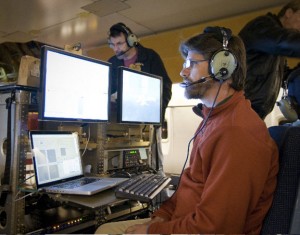Luke Keller, associate professor of physics at Ithaca College, has been working with NASA since 1999 to design technology that will gather new information from the universe. The SOFIA project, or Stratospheric Observatory for Infrared Astronomy, will function as the world’s largest airborne astronomical observatory. Keller helped to design the onboard infrared camera.
Staff Writer Shea O’Meara spoke to Keller about SOFIA, working with Ithaca College students and his future.

Shea O’Meara: What is the goal of the SOFIA project?
Luke Keller: The goal of the SOFIA project is to provide an infrared observatory for the international astronomy community, so it’s wavelengths of light that humans can’t see, and that is not usually visible from the surface of the Earth because the atmosphere absorbs the light before it gets to us. In fact, most light that comes from places where stars form, places where planets form and some of the distant universe, is in the infrared and therefore invisible unless you have an observatory or spacecraft to look at it. We’re basically providing the capability, and it’s going to be going for 20 years so people will probably be doing things we can’t even imagine right now.
SO: The project had a lot of holdups. How did you deal with those delays?
LK: It was very disappointing. When it was all on hold, our instrument was ready to go 10 years ago, so it was really frustrating to have things delayed. They were delayed for reasons we now understand and couldn’t be avoided, but it was really frustrating and in fact kind of scary. In 2006, NASA officially canceled the project because it was so overdue. So we did a big letter-writing push, and Peggy Williams, president of IC at the time, wrote a letter to Congress, and lots of people came together, so they reinstated the project, fortunately. It’s really exciting to see it fly and fly. We’re doing some astronomy research that really couldn’t be done without this facility.
SO: What has been the most exciting part of this experience?
LK: Two things — working with students and seeing them realize their work is appreciated by professional astronomers. I’ve been to meetings with students where they’ve demoed their software and NASA officials told them they had done a really great job and were going to use their software on the airplane. That’s pretty exciting. Then flying on the airplane and doing astronomy has been really spectacular for me.
SO: How did the six Ithaca College students get involved?
LK: Every spring, we have a meeting on a Tuesday at noon time and we tell the physics majors and other students about the research work we’re doing and see if students are interested in helping. I had students express interest — some were interested in the mechanics, some were interested in the software and some were interested in astronomy. I tried to braid their interest with the work I needed.
SO: Most of the students you’ve worked with have graduated. Are you looking to get new students involved?
LK: I’ve been on sabbatical for the past year — so I could work basically 100 percent on SOFIA— so I haven’t had any students working with me over the past year. [Sophomore Josh Cheng] had worked with me over the summer, and he’s actually going to be presenting his work with me at NCUR this spring. Other than that, I don’t have any [students] lined up, but we’re going to be having that meeting I was talking about in a few days, and I’m going to pitch the project and see if I can get some new students.
SO: Is there anything else you’d like to share about the SOFIA project and your work in the future?
LK: It’s not finished for me. In fact, we’re just getting started. I just got word that I have a new grant to continue working on SOFIA — just over $430,000 over the next couple of years. So I’ll be doing a lot more work with students, and we’re going to continue to use the observatory.
Read Keller’s blog about SOFIA at www.ithaca.edu/frequent_flyer.




